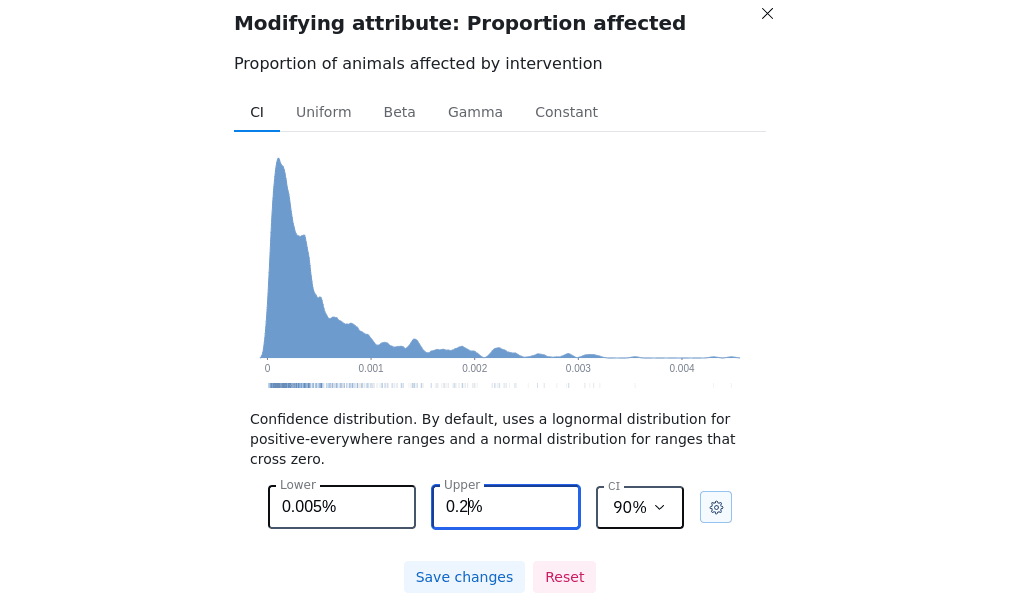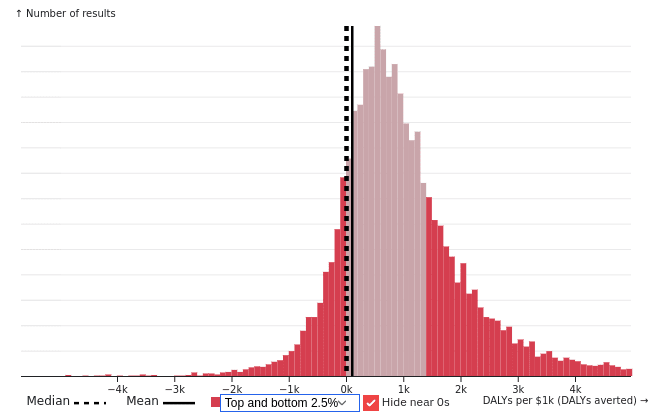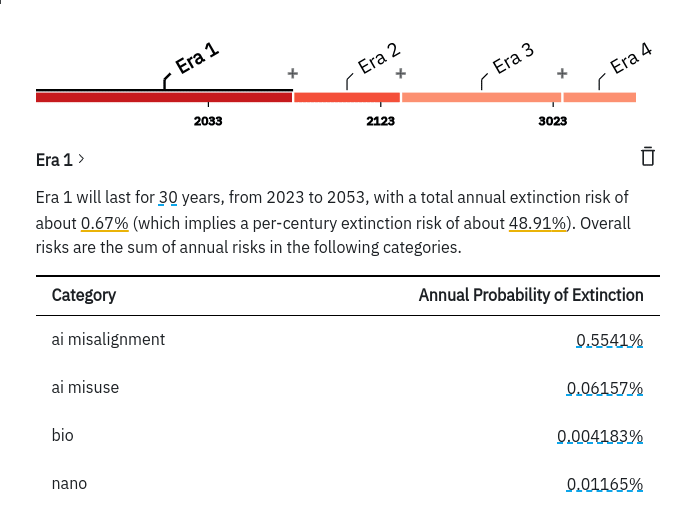Rethink Priorities’ Cross-Cause Cost-Effectiveness Model
This post is part of Rethink Priorities’ Worldview Investigations Team’s CURVE Sequence: “Causes and Uncertainty: Rethinking Value in Expectation.” The aim of this sequence is twofold: first, to consider alternatives to expected value maximization for cause prioritization; second, to evaluate the claim that a commitment to expected value maximization robustly supports the conclusion that we ought to prioritize existential risk mitigation over all else. This post presents a software tool we're developing to better understand risk and effectiveness.
Executive Summary
The cross-cause cost-effectiveness model (CCM) is a software tool under development by Rethink Priorities to produce cost-effectiveness evaluations in different cause areas.
- The CCM enables evaluations of interventions in global health and development, animal welfare, and existential risk mitigation.
- The CCM also includes functionality for evaluating research projects aimed at improving existing interventions or discovering more effective alternatives.
The CCM follows a Monte Carlo approach to assessing probabilities.
- The CCM accepts user-supplied distributions as parameter values.
- Our primary goal with the CCM is to clarify how parameter choices translate into uncertainty about possible results.
The limitations of the CCM make it an inadequate tool for definitive comparisons.
- The model is optimized for certain easily quantifiable effective projects and cannot assess many relevant causes.
- Probability distributions are a questionable way of representing deep uncertainty.
- The model may not adequately handle possible interdependence between parameters.
Building and using the CCM has confirmed some of our expectations. It has also surprised us in other ways.
- Given parameter choices that are plausible to us, existential risk mitigation projects dominate others in expected value in the long term, but the results are too high variance to approximate through Monte Carlo simulations without drawing billions of samples.
- The expected value of existential risk mitigation in the long run is mostly determined by the tail-end possible values for a handful of deeply uncertain parameters.
- The most promising animal welfare interventions have a much higher expected value than the leading global health and development interventions with a somewhat higher level of uncertainty.
- Even with relatively straightforward short-term interventions and research projects, much of the expected value of projects results from the unlikely combination of tail-end parameter values.
We plan to host an online walkthrough and Q&A of the model with the Rethink Priorities Worldview Investigations Team on Giving Tuesday, November 28, 2023, at 9 am PT / noon ET / 5 pm BT / 6 pm CET. If you would like to attend this event, please sign up here.
 Overview
Overview
Rethink Priorities’ cross-cause cost-effectiveness model (CCM) is a software tool we are developing for evaluating the relative effectiveness of projects across three general domains: global health and development, animal welfare, and the mitigation of existential risks. You can play with our initial version at ccm.rethinkpriorities.org and provide us feedback in this post or via this form.
The model produces effectiveness estimates, understood in terms of the effect on the sum of welfare across individuals, for interventions and research projects within these domains. Results are generated by computations on the values of user-supplied parameters. Because of the many controversies and uncertainties around these parameters, it follows a Monte Carlo approach to accommodating our uncertainty: users don’t supply precise values but instead specify distributions of possible values; then, each run of the model generates a large number of samples from these parameter distributions to use as inputs to compute many separate possible results. The aim is for the conclusions to reflect what we should believe about the spread of possible results given our uncertainty about the parameters.
Purpose
The CCM calculates distributions of the relative effectiveness of different charitable interventions and research projects so that they can be compared. Because these distributions depend on so many uncertain parameter values, it is not intended to establish definitive conclusions about the relative effectiveness of different projects. It is difficult to incorporate the vast number of relevant considerations and the full breadth of our uncertainties within a single model.
Instead, the outputs of the CCM provide evidence about relative cost-effectiveness. Users must combine that evidence with both an understanding of the model’s limitations and other sources of evidence to come to their own opinions. The CCM can influence what we believe even if it shouldn’t decide it.
In addition to helping us to understand the implications of parameter values, the CCM is also intended to be used as a tool to better grasp the dynamics of uncertainty. It can be enlightening to see how much very remote possibilities dominate expected value calculations and how small changes to some parameters can make a big difference to the results. The best way to use the model is to interact with it: to see how various parameter distributions affect outputs.
Key Features
We’re not the first to generate cost-effectiveness estimates for diverse projects or the first to make a model to do so. We see the value of the present model in terms of the following features:
We model uncertainty with simulations
As we’ve said, we’re uncertain about many of the main parameters that go into producing results in the model. To reflect that uncertainty, we run our model with different values for those parameters.
In the current version of the model, we use 150,000 independent samples from each of the parameter distributions to generate results. These samples can be thought of as inputs to independent runs. The runs generate an array of outcomes that reflect our proper subjective probability distribution over results. Given adequate reflection of our uncertainties about the inputs to the model, these results should cover the range of possibilities we should rationally expect.

We incorporate user-specified parameter distributions
To reflect uncertainty about parameters, the model generates multiple simulations using different combinations of values. The values for the parameters in each simulation are sampled from distributions over possible numbers. While we supply some default distributions based on what we believe to be reasonable, we also empower users to shape distributions to represent their own uncertainties. We include several types of distributions for users to select among; we also let them set the bounds and a confidence interval for their distribution of choice.
Our results capture outcome ineffectiveness
We are uncertain about the values of parameters that figure into our calculations of the expected value of our projects. We are also uncertain about how worldly events affect their outcomes. Campaigns can fail. Mitigation efforts can backfire. Research projects can be ignored. One might attempt to capture the effect of such random events by applying a discount to the result: if there is a 30% chance that a project will fail, we may simply reduce each sampled value by 30%. Instead, we attempt to capture this latter sort of uncertainty by randomly determining the outcomes of certain critical events in each simulation. If the critical events go well, the simulation receives the full calculated value of the intervention. If the critical events go otherwise, that simulation records no value or negative value.
Many projects stand to make a large positive difference to the world but only are effective under the right conditions. If there is some chance that our project will fail, we can expect the model’s output ranges to include many samples in which the intervention makes no difference.
Including the outcomes of worldly events helps us see how much of a risk there is that our efforts are wasted. This is important for accurately measuring risk under the alternative decision procedures explored elsewhere in this sequence.
We enable users to specify the probability of extinction for different future eras
We put more work into our calculations around the value provided by existential risk mitigation compared with other cause areas. Effectiveness evaluations in this cause area are both sensitive to particularly complex considerations and relatively less well explored.
One critical feature to assessing the effect of existential risk mitigation is the number of our descendants. This depends in part on how long we last before extinction, which in turn depends on the future threats to our species. We make it possible for users to capture their own views about risk by specifying custom risk predictions that include yearly risk assessments for the relevant periods over the coming millennia.
Structure
The tool contains two main modules.
First, the model contains a module for assessing the effectiveness of interventions directly aimed at making a difference. This tool utilizes sub-models for evaluating and comparing interventions addressing global health and development, animal welfare, and existential risk mitigation.
Second, the model contains a module for comparing the effectiveness of research projects intended to improve the effectiveness of money spent on direct interventions. This tool combines parameters concerning the probability of finding and implementing an improvement with the costs incurred by the search.
Intervention module
The intervention assessment module provides evaluations of the effectiveness of interventions within three categories: global health and development, animal welfare, and existential risk mitigation. The effectiveness of interventions within each category is reported in DALYs-averted equivalent units per $1000 spent on the current margin.
Given the different requirements of interventions with distinct aims, the CCM relies on several sub-models to calculate intervention effectiveness of different kinds.
Global Health and Development
We include several benchmark estimates of cost-effectiveness for global health and development charities to assess the relative effectiveness of animal welfare and existential risk projects. We draw these estimates from other sources, such as GiveWell, that we expect to be as reliable as anything we could produce ourselves. However, these estimates don’t incorporate uncertainty. To try to account for this and to express our own uncertainties about these estimates, we use distributions centered on the estimates.
Animal Welfare
Our animal welfare model assesses the effects of different interventions on welfare among farmed animal populations. The parameters that go into these calculations include the size of the farmed population, the proportion that will be affected, the degree of improvement in welfare, and the costs of the project (among others.)
Since the common unit of value used to compare interventions is assessed in disability-adjusted human life years, we discount the well-being of non-human animals based on their probability of sentience and capacities for welfare. Our default values are based on the findings of the Moral Weight Project, though they can be changed to reflect a wide range of views about the moral considerations that bear on human/animal and animal/animal tradeoffs.
Existential Risk Mitigation
Our existential risk model estimates the effect that risk mitigation has on both preventing near-term catastrophes and extinction. In both cases, we calculate effectiveness in terms of the difference the intervention makes in years of human life lived.
We assume that existential risk mitigation work may lower (or accidentally raise) the chance of risk of catastrophic or existential events over a few decades, but has no perpetual impact on the level of risk. The primary value of an intervention is in helping us safely make it through this period. In many of the samples, the result of our model’s randomization means that we do not suffer an event in the coming decades regardless of the intervention. If that happens, or if we suffer an event despite the intervention, this means that the intervention provides no benefit for its cost. In some others, the intervention allows our species to survive for thousands of years, gradually colonizing the galaxy and beyond. In yet others, our efforts backfire and we bring about an extinction event that would not otherwise have occurred.
The significance of existential risk depends on future population sizes. In response to the extreme uncertainty of the future, we default to a cutoff point in a thousand years, where the population is limited by the Earth’s capacity. However, we make it possible to expand this time frame to any degree. We assume that, given enough time, humans will eventually expand beyond our solar system, and for simplicity accept a constant and equal rate of colonization in each direction. The future population of our successors will depend on the density of inhabitable systems, the population per system, and the speed at which we colonize them. Given the high growth rate of a volume with constant diameter expansion, we find that the speed of expansion and the time until extinction are the most important factors for deciding effectiveness. Interventions can have an extraordinarily high mean effectiveness even if, the vast majority of the time, they do nothing.
Research projects module
The research projects sub-module provides evaluations of research projects aimed at improving the quality of global health and development and animal welfare intervention work. These research projects make a difference in the cost-effectiveness of money spent on a project if successful. However, they are often speculative and fail to find an improvement; or, they find an improvement that is not adopted. The sub-module lets users specify the effect of moving money from an intervention with a certain effectiveness to another hypothetical intervention of higher effectiveness, then, it creates an assessment of the value of the research due to promoting that change.
If a research project succeeds in finding an improvement in effectiveness, the value produced depends on how much money is influenced as a result. Research isn’t free, and so we count the costs of research in terms of the counterfactual use of that money on interventions themselves.
Limitations
The intervention module has several significant limitations that reduce its usefulness for generating cross-cause comparisons of cost-effectiveness. All results need to be interpreted carefully and used judiciously.
It is geared towards specific kinds of interventions
The sub-models for existential risk mitigation and animal welfare abstract some of the particularities of the interventions within their domain to allow them to represent different interventions following a similar logic. They are far from completely general. The animal welfare model is aimed at interventions reducing the suffering of animals. Interventions aimed at promoting vegetarianism, which have an indirect effect on animal suffering, are not represented. The existential risk mitigation model is aimed at interventions lowering the near-term risk of human extinction. Many other long-termist projects, such as projects aimed at improving institutional decision-making or moral circle expansion, are not represented.
Other interventions would require different parameter choices and different logic to process them. The sorts of interventions we chose to represent are reasonably general, believed to be highly effective in at least some cases, and of particular interest to Rethink Priorities. We have avoided attempting to model many idiosyncratic or difficult-to-assess interventions, but that leaves the model radically incomplete for general evaluative purposes.
Distributions are a questionable way of handling deep uncertainty
We represent our uncertainty about parameters with distributions over possible values. This does a good job of accounting for some forms of uncertainty. To take advantage of this, users must take care to pay attention not just to mean values but also to the variety of results.
However, representing uncertainty with distributions requires knowing which distributions to choose. Often, when faced with questions about which we are truly ignorant, it is hard to know where to place boundaries or how to divide the bulk of the values. Representing uncertainties with distributions can give us a false sense of confidence that our ignorance has been properly incorporated when we have really replaced our uncertainties with a somewhat arbitrary distribution.
The model doesn’t handle model uncertainty
Where feasible, the CCM aims to represent our uncertainty within the model so as to produce results that incorporate that uncertainty. However, not all forms of uncertainty can be represented within a model. While a significant amount of uncertainty may be in the values of parameters, we may also be uncertain about which parameters should be included in the model and how they should relate to each other. If we have chosen the wrong set of parameters, or left out some important parameters, the results will fail to reflect what we should believe. If we have left out considerations that could lower the value of some outcomes, the results will be overly optimistic. If we’re not confident that our choice of parameters is correct, then the model’s estimates will fall into a narrower band than they should.
The model assumes parameter independence
We generate the value of parameters with independent samples from user-supplied distributions. The values chosen for each parameter have no effect on the values chosen for others. It is likely that some parameters should be dependent on each other, either because the underlying factors are interrelated or because our ignorance about them may be correlated. For example, the speed of human expansion throughout may be correlated with the probability of extinction by each year in the far future. Or, the number of shrimp farmed may be correlated with the proportion of shrimp we can expect to affect. Interdependence would suggest that the correct distribution of results will not have the shape that the model actually produces. We mitigate this in some cases by deriving some values from the parameters based on our understanding of their relationship, but we can’t fully capture all the probabilistic relationships between parameter values and we generally don’t try to.
Lessons
Despite the CCM’s limitations, it offers several general lessons.
The expected value of existential risk mitigation interventions depends on future population dynamics
For all we knew at the outset, many factors could have played a significant role in explaining the possible value of existential risk mitigation interventions. Given our interpretation of future value in terms of total welfare-weighted years lived, it turns out that the precise amount of value depends, more than anything, on two factors: the time until our successors go extinct and the speed of population expansion. Other factors, such as the value of individual lives, don’t make much of a difference.
The size of the effect is so tremendous that including a high expansion rate in the model as a possibility will lead existential risk to have extremely high expected cost-effectiveness, practically no matter how unlikely it is. Each of these two factors is radically uncertain. We don’t know what might cause human extinction assuming that we should survive for a thousand years. We have no idea how feasible it will be for us to colonize other systems. Thus, the high expected values produced by a model reflect the fact that we can’t rule out certain scenarios.
The value of existential risk mitigation is extremely variable
Several factors combine to make existential risk mitigation work particularly high variance.
We measure mitigation effectiveness by the proportional reduction of yearly risk. In setting the defaults, we’ve also assumed that even if the per-century risk is high, the yearly risk is fairly low. It also seemed implausible to us that any single project, even a massive billion-dollar megaproject, would remove a significant portion of the risk of any given threat. Furthermore, for certain kinds of interventions, it seems like any project that might reduce risk might also raise it. For AI, we give this a nontrivial chance by default. Finally, in each simulation, the approximate value of extinction caused or prevented is highly dependent on the precise values of certain parameters.
The result of all this is that even with 150k simulations, the expected value calculations on any given run of the model (allowing a long future) will swing back and forth between positive and negative values. This is not to say that expected value is unknowable. Our model does even out once we’ve included billions of simulations. But the fact that it takes so many demonstrates that outcome results have extremely high variance and we have little ability to predict the actual value produced by any single intervention.
Tail-end results can capture a huge amount of expected value
One surprising result of the model was how much of the expected value of even less speculative projects and interventions comes from rare combinations of tail-end samples of parameter values. We found that some of the results that could not fit into our charts because the values were too rare and extreme could nevertheless account for a large percentage of the expected value.
This suggests that the boundaries we draw around our uncertainty can be very significant. If those boundaries are somewhat arbitrary, then the model is likely to be inaccurate. However, it also means that clarifying our uncertainty around extreme parameter values may be particularly important and neglected.
Unrepresented correlations may be decisive
Finally, for simplicity, we have chosen to make parameters independent of each other. As noted above, this is potentially problematic: even if we represent the right parameters with the right distributions, we may overlook correlations between those distributions. The previous lessons also suggest that our uncertainty around correlations in high-variance events might upend the results.
If we had reason to think that there was a positive relationship between how likely existential risk mitigation projects were to backfire and how fast humanity might colonize space, the expected value of mitigation work might turn out to be massively negative. If there were some reason to expect a certain correlation between the moral weight of shrimp and the populations per inhabitable solar system, for instance, if a high moral weight led us to believe digital minds were possible, the relative value the model assigns to shrimp welfare and risks from runaway AI work might look quite different.
This is interesting in part because of how under-explored these correlations are. It is not entirely obvious to us that there are critical correlations that we haven’t modeled, but the fact that such correlations could reverse our relative assessments should leave us hesitant to casually accept the results of the model. Still, absent any particular proposed correlations, it may be the best we’ve got.
Future Plans
We have learned a lot from the process of planning and developing the CCM. It has forced us to clarify our assumptions and to quantify our uncertainty. Where it has produced surprising results, it has helped us to understand where they come from. In other places, it has helped to confirm our prior expectations.
We will continue to use and develop it at Rethink Priorities. The research projects module was built to help assess potential research projects at Rethink Priorities and we will use it for this purpose. We will test our parameter choices, refine its verdicts, and incorporate other considerations into the model. We also hope to be able to expand our interventions module to incorporate different kinds of interventions.
In the meantime, we hope that others will find it a valuable tool to explore their own assumptions. If you have thoughts about what works well in our model or ideas about significant considerations that we’ve overlooked, we’d love to hear about it via this form, in the comments below, or at dshiller@rethinkpriorities.org.
Acknowledgements
The CCM was designed and written by Bernardo Baron, Chase Carter, Agustín Covarrubias, Marcus Davis, Michael Dickens, Laura Duffy, Derek Shiller, and Peter Wildeford. The codebase makes extensive use of Peter Wildeford's squigglepy and incorporates componentry from quri's squiggle library.
This overview was written by Derek Shiller. Conceptual guidance on this project was provided by David Rhys Bernard, Hayley Clatterbuck, Laura Duffy, Bob Fischer, and Arvo Muñoz Morán. Thanks also to everyone who reported bugs or made suggestions for improvement. The post is a project of Rethink Priorities, a global priority think-and-do tank, aiming to do good at scale. We research and implement pressing opportunities to make the world better. We act upon these opportunities by developing and implementing strategies, projects, and solutions to key issues. We do this work in close partnership with foundations and impact-focused non-profits or other entities. If you're interested in Rethink Priorities' work, please consider subscribing to our newsletter. You can explore our completed public work here.




